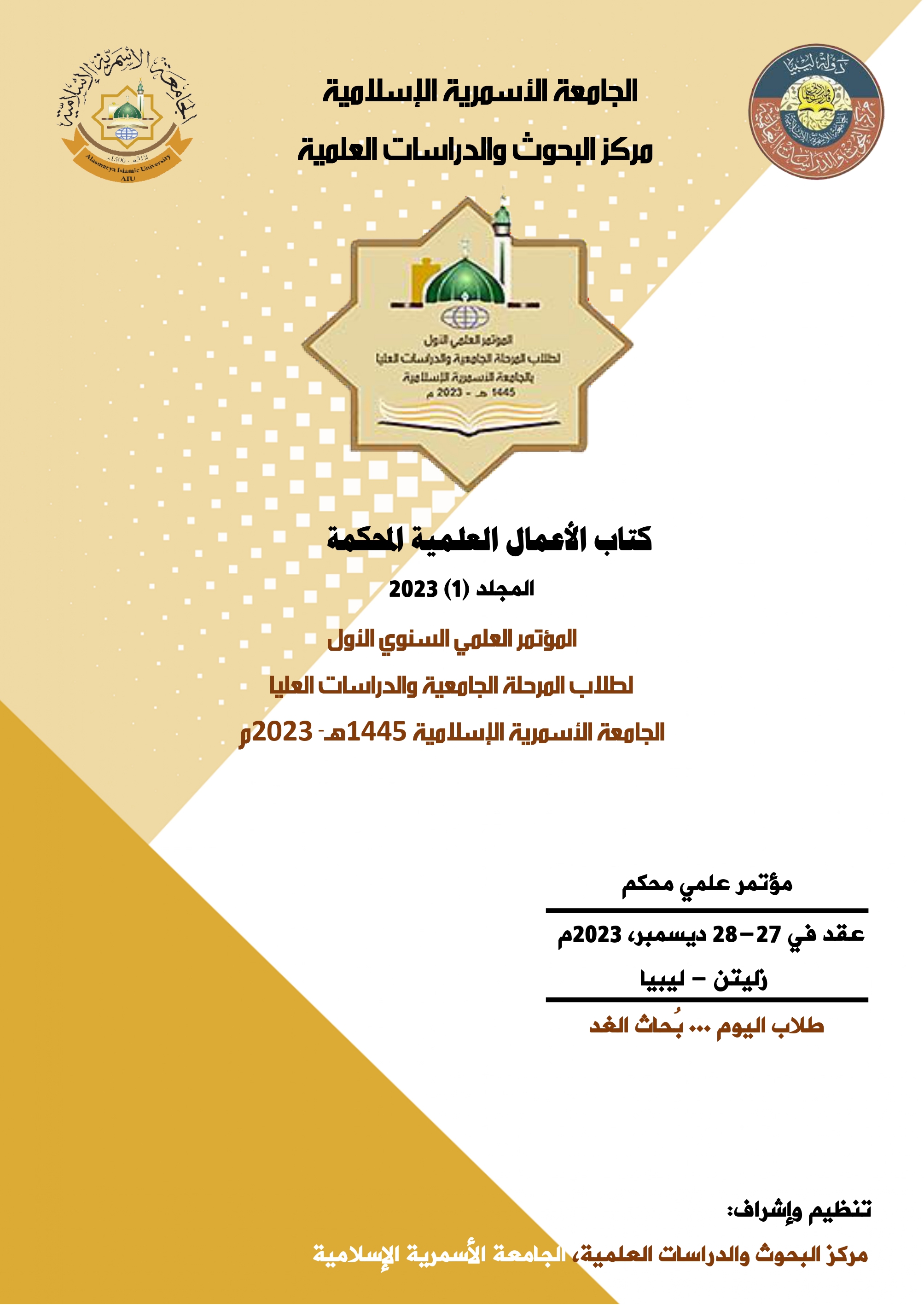مرض حساسية الجلوتين الأسباب والعلاج ومدى انتشاره في مدينة زليتن
الكلمات المفتاحية:
حساسية الجلوتين، حساسية القمح، سوء التغذية، مرض السيلياك، مرض داء البطنالملخص
يعرف مرض حساسية الجلوتين بمرض السيلياك Celiac Disease أو داء البطن وهو مرض ينتج من عدم تحمل الجسم الجلوتين. حيث هدفت هذه الدراسة لحصر مرضى حساسية القمح في مدينة زليتن، وكذلك معرفة بعض المعلومات عن هذا المرض، حيث أدرجت في هذ الدراسة إحصائية للمرضى الذين يعانون من مرض حساسية الجلوتين في مدينة زليتن ما بين عامي 2020-2022م المسجلين في مجمع عيادات الغوبلات، وكان مدى انتشار المرض 0.124% في مدينة زليتن خلال هذه الفترة. وتمت هذه الدراسة عن طريق توزيع استبانة ورقية على الأفراد المصابين بالمرض الذين يترددون على مجمع عيادات الغويلات، حيث كان عدد أفراد العينة 74 فرداً مصاباَ بمرض حساسية القمح. أوضحت نتائج الدراسة أن 41% من المرضى ذكوراً، و 55.4% إناثاً، وكان أغلب أفراد عينة الدراسة أعمارهم من 20 إلى أقل من 40 سنة بنسبة (59.7%) من إجمالي عينة الدراسة، و كانت طريقة اكتشافهم للمرض هو فحص الدم بنسبة (66.2%)من إجمالي العينة، و(33%) منهم كانت عن طريق أخد خزعة من الأمعاء، وكانت نسبة الذين لا يوجد لديهم أقارب يعانون من نفس المرض (53.5%) من إجمالي العينة، وكان معظم أفراد العينة لديهم أمراض أخرى إضافة لهذا المرض منهم أفراد مصابون بمرض فقر الدم بنسبة (40.3%) من إجمالي العينة و بعضهم يعانون من جفاف و احمرار بالجلد بنسبة (22.2%) من إجمالي العينة، و كانت نسبة أفراد العينة الذين يتبعون حمية غذائية بانتظام (54.2%)من الإجمالي، وكان أكثر الأشخاص الذين لم يتبعوا حمية غذائية سببها هو عدم توفر أغدية خاصة بالمرض بنسبة (64.1%) من الإجمالي, ومعظم الأفراد ممن كانوا ملتحقين بجمعيات توزع لهم الغذاء الخاص بهم أجابوا أن هذه الجمعيات لا توفر لهم جميع الأغدية بنسبة (90.1%)، وأجابوا أيضا بأن الهيئة الصحية لا تقوم بالدور التوعوي بالمستوى المطلوب بنسبة (63.9%). لذلك فإن من أهم التوصيات اتباع حمية غذائية خالية من الجلوتين، كما يجب على المنظمات الخاصة توفير الأغذية الخاصة لمرضى حساسية القمح، وإجراء مسحات وبحوث واسعة الرقعة لهذا المرض في مدينة زليتن خاصة وليبيا عامة للتعرف على العدد الفعلي للمرضى، وكذلك التعرف على المعلومات ذات الصلة بهذا المرض ونشر الوعي الصحي بين المرضى.
التنزيلات
المراجع
أولا: قائمة المراجع باللغة الإنجليزية
Alarida, K., Harown, J., Ahmaida, A., Marinelli, L., Venturini, C., Kodermaz, G., ... & Catassi, C. (2011). Coeliac disease in Libyan children: a screening study based on the rapid determination of anti-transglutaminase antibodies. Digestive and Liver Disease, 43(9), 688-691.
Brar, P., Lee, A. R., Lewis, S. K., Bhagat, G., & Green, P. H. (2006). Celiac disease in African-Americans. Digestive Diseases and Sciences, 51, 1012-1015.
Ciacci, C., Iovino, P., Amoruso, D., Siniscalchi, M., Tortora, R., Di Gilio, A., ... & Mazzacca, G. (2005). Grown‐up coeliac children: the effects of only a few years on a gluten‐free diet in childhood. Alimentary Pharmacology & Therapeutics, 21(4), 421-429.
Dewar, D. H., Amato, M., Ellis, H. J., Pollock, E. L., Gonzalez-Cinca, N., Wieser, H., & Ciclitira, P. J. (2006). The toxicity of high molecular weight gluten in subunits of wheat to patients with coeliac disease. European Journal of Gastroenterology & Hepatology, 18(5), 483-491
Dvorak, M. (2005). Gluten enteropathy--occurrence, diagnosis, therapy. Casopis Lekaru Ceskych, 144, 48-51.
Green, P. H., & Cellier, C. (2007). Celiac disease. New England Journal of Medicine, 357(17), 1731-1743.
Heredia, P., Castro, P., and Plama, H. (2007). Adult Celiac Disease. Rev Med Chil., 135(9), 1186-94.
Hoffenberg, E.; MacKenzie, T.; Barriga, K.; Eisenbarth, G.; Bao, F. and Haas, J. (2003). prospective study of the incidence of childhood celiac disease. J Pediatr.143:308¬ -14
Högberg, L., Laurin, P., Fälth-Magnusson, K., Grant, C., Grodzinsky, E., Jansson, G., ... & Stenhammar, L. (2004). Oats to children with newly diagnosed coeliac disease: A Randomised double blind study. Gut, 53(5).
Hozyasz, K. & Czerwińska, B. (2004). Atypical celiac disease in an adolescent girl--case report. Polski Merkuriusz Lekarski: Organ Polskiego Towarzystwa Lekarskiego, 17(101), 491-493
Lange, E. (2007). Oat products in gluten free diet. Roczniki Panstwowego Zakladu Higieny, 58(1), 103-109.
Malekzadeh, R., Sachdev, A., & Ali, A. F. (2005). Coeliac disease in developing countries: middle East, India and North Africa. Best Practice & Research Clinical Gastroenterology, 19(3), 351-358.
Mancilla , A., Madrid , S., Valenzvela, E., Morales, B., Hurtado, H., Smok, S., Ledezma, R., Castillo, M., Rivas, Q., and Brahm, B. (2005). Adult celiac disease: elinical experience. Rev. Med. chil., 133 (11), 1317 -21.
Meloni, G. F., Dessole, S., Vargiu, N., Tomasi, P. A., & Musumeci, S. (1999). The prevalence of coeliac disease in infertility. Human Reproduction, 14(11), 2759-2761
ثانيا: قائمة المراجع باللغة العربية
إدريس ه. بوعتيق، ر. (2021). الحساسية الغذائية عند الأطفال وجودة المتابعة التغذوية. مجلة جامعة سبها للعلوم البحثية والتطبيقية، 20(2)، 1403.
التنزيلات
منشور
إصدار
القسم
الرخصة
الحقوق الفكرية (c) 2023 حنان محمد انويدر، حنان إسماعيل أبوصلاح، هاجر مصباح شابك

هذا العمل مرخص بموجب Creative Commons Attribution 4.0 International License.





